
Original Link: https://www.anandtech.com/show/1637
OCZ VX Memory + DFI nForce4 = DDR533 at 2-2-2
by Wesley Fink on March 4, 2005 6:45 AM EST- Posted in
- Memory
In the past year, we have seen lots of memory rated at DDR500, so you may wonder why we are reviewing a new DDR500 memory today when there are now a few rare modules rated as high as DDR600. The answer is pretty simple, since OCZ PC4000 VX Gold is the only memory that we have ever seen rated at DDR500 2-2-2. While it is rated at DDR500 at these extraordinary 2-2-2 timings, it also carries a very high rated voltage of 3.3V - far beyond what most motherboards can supply.
A quick check of orbs at FutureMark will show that this new VX is the fast darling of the extreme overclocking market. For those who wondered why DFI included voltages to 4.0V in their new nForce4 Ultra and SLI motherboards, the answer is OCZ VX memory. With VX needing voltages as high as 3.7V to really reach top performance at certain speeds, the DFI LANParty nF4 SLI-DR and DFI LANParty UT nF4 Ultra-D are the first production motherboards to support the kind of extreme voltages needed by VX without modification.
With this promise of extraordinary DDR500 2-2-2 performance, we were very interested to see if this performance promise was real. Have we finally reached DDR500 with the fastest timings available? The answers in our benchmarks are very interesting.
OCZ EL PC4000 VX Gold
OCZ has developed quite a reputation in the past year with the introduction of many leading-edge memory products. As you will see in a look at our ongoing memory benchmarks, the results have been that OCZ owns many of the top performance spots in our memory tests. Even with that kind of reputation, OCZ VX must be counted a unique product. The EL label is used by OCZ for Extreme Latency, but VX is a new label used to refer to Voltage eXtreme memory. VX means that the memory is designed for and can handle very high memory voltages for expanded performance.The first OCZ VX memory was rated at a very conservative PC3200 2-3-3-8 at a standard 2.6V. While it met these specifications, the specs hardly described a memory that was widely recognized as capable of DDR500 and higher at 2-2-2 timings using voltages of 3.0V and higher. As yields and binning improved, OCZ decided in late February to introduce an updated VX memory - now rated at DDR500 2-2-2 at 3.3V.
The new DDR500 2-2-2 uses the same chips as the earlier VX, but it is binned for higher speed and verified at the new DDR500 specifications. OCZ tells us that everything about the new VX memory is basically the same as earlier PC3200VX, but with even better chips becoming available for VX, it was time for the higher speed rating. OCZ will also be introducing a VX value memory in the future for those enthusiasts that want 2-2-2 timings, but do not demand DDR500+ timings for 2-2-2. Gold VX modules are optimized for use on Athlon 64 based motherboards. In addition, OCZ EL PC-4000 Gold VX is rated to handle up to 3.5V without invalidating the OCZ lifetime warranty.

The new VX DDR500 uses the familiar OCZ Gold heatspreaders. OCZ describes the heatspreaders as gold-mirrored copper, and DDR500 VX is only available as a 1GB kit with two 512MB double-sided memory modules. We removed the heatspreader and found the memory chips were labeled OCZ. OCZ apparently buys memory chip blanks and relabels them for VX. OCZ is usually very open about chip sources, but in this case, they would only comment that the memory chips were made to their specifications and went through extensive binning at OCZ. Forums are claiming that the blank is a new Winbond memory chip.
The recently tested DFI LANParty nForce4 boards are the only current production boards to fully support the voltages required by VX memory. It is fortunate that the DFI are also excellent performers and the DFI LANParty nF4 SLI-DR was the recent winner of our Gold Editors Choice in the nForce4 SLI roundup. The DFI boards are only recently available, however, and prior to the DFIs, there were two ways to use VX memory. First, some enthusiasts modified their boards to supply higher memory voltage.
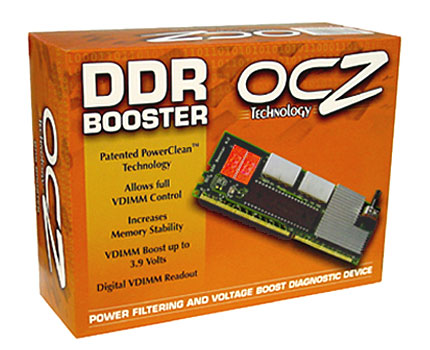
Second, you could use VX with an OCZ DDR Booster, which is a device designed to fit into the DIMM slot of most motherboards.
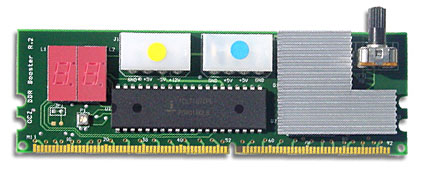
The DDR Booster is a little $40 device that allows the user to select voltages up to 3.9V regardless of what voltages the motherboard supports. This neatly gets around the fact that most motherboards supply only 2.7V to 2.85V to the memory slots. For motherboards other than the DFI, you can even buy a bundle of VX memory with the DDR booster.
OCZ EL PC4000 VX Gold Specifications
| OCZ EL PC4000 VX Gold Memory Specifications | |
| Number of DIMMs & Banks | 2 DS |
| DIMM Size Total Memory |
512 MB |
| Rated Timings | 2-2-2-8 at DDR500 at 3.3V 2-3-3-8 at DDR400 at 2.6V (Typically 2-2-2-8 at DDR400 at 3.0V) |
| SPD (Auto) Timings | 3-3-3-8 |
| Rated Voltage | 3.3V |
With Intel's introduction last summer of the Intel 915/925X chipsets with support for DDR2 memory, the primary market for DDR memory has become the excellent AMD Athlon 64 platform. However, some 915 boards also support DDR, and the continuing Intel Socket 478 also supports DDR memory. It is worth noting that OCZ designed PC4000VX for the AMD platform and it is optimized for the Athlon 64 platform. In addition, the only unmodified motherboard for VX is the DFI nForce4 motherboards. For these reasons, OCZ EL PC4000 VX Gold was only tested on the DFI LANParty nF4 SLI-DR Athlon 64 Socket 939 test bed.
Performance Test Configuration
The OCZ VX DDR500 was tested with the DFI LANParty nF4 SLI-DR Athlon 64 Socket 939 motherboard. The new DFI nForce4 SLI and Ultra are the only current production boards that support the voltages required for top VX performance. An OCZ DDR Booster can be used with motherboards without support for high memory voltages. Other components remain the same as used in the memory setup in Athlon 64 Memory: Rewriting the Rules .All other memory tests were run earlier on the MSI K8N Neo2, based on the nForce 3 Ultra. We have already shown performance of the nF3 and nF4 to be virtually identical in our launch reviews of the nForce4 chipset. Similarly AGP and PCIe performance has been shown to be virtually the same using the same video card (6800 Ultra AGP vs. 6800 Ultra PCIe. For these reasons we did not retest earlier memory on the DFI. However, we were concerned about the potential performance difference in 61.77 video drivers compared to 71.80, so we ran a quick set of comparisons. 71.80 drivers were slightly faster in game benchmarks than 71.80 and slightly slower than 61.77 in memory bandwidth tests. However, the differences were small enough that we were confident the results were not seriously distorted by using the 71.80 drivers.
The A64 test bed for testing the OCZ VX and the standard MSI test bed both include components that have been proven in Socket 939 Athlon 64 benchmarking, such as the Socket 939 FX53 (same specifications as current 4000+), and the OCZ Power Stream 520 Power Supply. Since the Athlon 64 tests represent a new series of DDR testing, we have chosen the current generation nVidia 6800 Ultra video card for benchmarking. We have found the 6800 Ultra to be a particularly good performance match to nVidia motherboards.
All other basic test conditions attempted to mirror those used in our earlier Intel memory reviews. However, test results are not directly comparable to tests performed on the Intel test bed.
| AMD nForce4 Performance Test Configuration | |
| Processor(s): | AMD FX53 Athlon 64 (2.4GHz, Socket 939, 1 MB cache, Dual Channel, 1000HT) |
| RAM: | OCZ EL PC4000 VX Gold (DS) 2X512MB Corsair TwinX1024-4400C25 (DS) 2X512MB G. Skill TCCD (DS) 2X512MB PQI 3200 Turbo (DS) 2X512MB Crucial Ballistix (DS) 2X512MB Geil PC3200 Ultra X (DS) 2X512MB OCZ PC3200 Platinum Rev 2 (DS) 2X512MB OCZ PC3700 Gold Rev 3 (DS) 2X512MB |
| Hard Drives: | Seagate 120GB PATA (IDE) 7200RPM 8MB Cache |
| PCI/AGP Speed: | Fixed at 33/66 |
| Video Card(s): | nVidia 6800 Ultra 256MB, 256MB aperture, 1024x768x32 |
| Video Drivers: | nVidia Forceware 71.80 nVidia Forceware 61.77 |
| Power Supply: | OCZ Power Stream 520W |
| Operating System(s): | Windows XP Professional SP1 |
| Motherboards: | DFI LANParty nF4 SLI-DR MSI K8N Neo2 Platinum (nForce3) |
With nForce3 motherboards, we achieved the fastest performance on AMD Athlon 64 chipsets (nForce3, VIA K8T800 PRO) at Cycle Time or tRAS of 10. However, as we saw in the recent nForce4 SLI roundup, the nForce4 appears to behave a bit differently with memory. In the SLI roundup, we found a tRAS of 7 to be ideal for memory based on Samsung TCCD chips. Therefore, we ran a complete set of Memtest86 benchmarks with only tRAS varied to determine the best tRAS setting for OCZ VX.
| Memtest86 Bandwidth DFI nForce4, Athlon64 4000+, OCZ VX |
|
| 2 tRAS | 2572 |
| 3 tRAS | 2572 |
| 4 tRAS | 2572 |
| 5 tRAS | 2640 |
| 6 tRAS | 2640 |
| 7 tRAS | 2640 |
| 8 tRAS | 2505 |
| 9 tRAS | 2505 |
| 10 tRAS | 2505 |
| 11 tRAS | 2441 |
| 12 tRAS | 2383 |
These tests are particularly easy to do with the DFI nF4 boards, since memtest86 is built into the BIOS. To boot memtest86, you only have to enable it in BIOS and the system will boot directly into memtest86. This makes it very easy to test various memory timings, but memtest86 should be disabled in BIOS when you are ready to boot into the system.
The best memory bandwidth with VX and the 4000+ was achieved in the tRAS 5 to tRAS 7 range. Therefore, all VX testing was done with a tRAS setting of 6.
Test Settings
All AMD Athlon 64 processors are unlocked downward, and the FX CPUs are unlocked up and down. This feature allows a different approach to memory testing, which truly measures performance differences in memory speed alone. All tests were run with CPU speed as close to the specified 2.4GHz of the 4000+/FX53 as possible, with CPU speed/Memory Speed increased at lower multipliers to achieve 2.4Ghz. This approach allows the true measurement of the impact of higher memory speed and timings on performance, since CPU speed is fixed, removing CPU speed as a factor in memory performance.The following settings were tested with the OCZ EL PC4000 VX Gold on the DFI nF4 test bed:
- 2.4GHz at 12x200 (DDR400) - the highest stock memory speed supported on K8T800-Pro/nF3-4/SiS755-FX motherboards.
- 2.4GHz at 11x218 (DDR436) - a ratio near the standard DDR433 speed
- 2.4GHz at 10x240 (DDR480) - a ratio near the standard rating of DDR466
- 2.4GHz at 9x267 (DDR533) - a standard memory speed used in testing other high-speed memory
- Highest Memory Speed - the highest memory speed that we could achieve regardless of the multiplier. This setting was achieved at a 1T command rate with the VX, so this is also the result that produces the best memory performance.
We ran our standard suite of memory performance benchmarks - Quake 3, Return to Castle Wolfenstein-Enemy Territory-Radar, Super Pi 2M, and Sandra 2004 Standard and UnBuffered. Since the results for Athlon 64 tests are new, we are now including Sandra Buffered (Standard) test results and Sandra UnBuffered test results. RTCW Enemy Territory has also been added as a standard memory benchmark.
Test Results: OCZ EL PC4000 VX Gold
To be considered stable for test purposes, Quake3 benchmark, UT2003 Demo, Super PI, Aquamark 3, and Comanche 4 had to complete without incident. Any of these, especially Super PI, will crash a less-than stable memory configuration.| OCZ EL PC4000 VX Gold (DDR500) - 2x512Mb Double-Bank | |||||||
| CPU Ratio at 2.4GHz | Memory Speed | Memory Timings & Voltage |
Quake3 fps |
Sandra UNBuffered | Sandra Standard Buffered |
Super PI 2M places (time in sec) |
Wolfenstein - Radar - Enemy Territory fps |
| 12x200 | 400 DDR (Stock V) |
2-3-2-6 2.6V 1T (Stock V) |
567.4 | INT 2856 FLT 2998 |
INT 6130 FLT 6082 |
81 | 119.3 |
| 12x200 | 400 DDR | 2-2-2-6 3.0V 1T |
572.6 | INT 2920 FLT 3065 |
INT 6150 FLT 6098 |
80 | 120.3 |
| 11x218 | 436 DDR | 2-2-2-6 3.1V 1T |
580.6 | INT 3077 FLT 3253 |
INT 6538 FLT 6467 |
80 | 121.4 |
| 10x240 | 480 DDR | 2-2-2-6 3.2V 1T |
600.5 | INT 3234 FLT 3404 |
INT 6804 FLT 6727 |
78 | 123.4 |
| 9x267 | 533 DDR | 2-2-2-6 3.5V 1T |
601.5 | INT 3477 FLT 3679 |
INT 7143 FLT 7056 |
77 | 124.9 |
| 9x269 (2.42GHz) |
Highest 1T Mem Speed 538 DDR |
2-2-2-6 3.6V 1T |
602.3 | INT 3477 FLT 3683 |
INT 7169 FLT 7106 |
77 | 125.2 |
| 10x250 (2.5Ghz) |
Rated Speed 500 DDR |
2-2-2-6 3.2V 1T |
612.2 | INT 3364 FLT 3557 |
INT 7093 FLT 7009 |
75 | 128.4 |
| 10x267 (2.67GHz) |
Highest CPU/MEM Performance | 2-2-2-6 3.5V 1T |
645.0 | INT 3470 FLT 3629 |
INT 7554 FLT 7461 |
71 | 135.8 |
The top row of Performance results at 2.6V is included as a performance baseline. While VX cannot achieve 2-2-2 timings at stock voltage at DDR400, it can easily be coaxed into 2-2-2 performance at DDR400 with more voltage. With these modules, we reached an extremely stable DDR400 2-2-2-6 at 3.0V. We then maintained 2-2-2-6 timings all the way to DDR538, which required 3.6V for complete stability. The voltage requirements from 3.0 to 3.6 volts were very linear to Memory Speed.
The important results here are rows 1 to 6, where CPU speed is kept at 2.4GHZ and only the Memory Speed is varied. The performance differences that you see in that range are a result of Memory Speed only. In the case of VX, where memory timings also remain constant, the true impact of just memory speed can be seen. It is not a huge difference in real-world benchmarks, but the increase is real nonetheless.
However, speed from 400 to 533 is not the only thing that is important with OCZ VX. Please take a look at VX performance in our later performance comparisons. Look at each of these speeds, comparing VX to the best AMD TCCD and other memory that we have tested, and you will see something very interesting. VX is faster at every speed than competing memory that we have tested. This means that all 2-2-2 is not created equal, as VX is faster at every speed than the competition at 2-2-2.
| OCZ EL PC4000 VX Gold (DDR500) 2x512Mb Double-Bank |
||||
| CPU Ratio at 2.4GHz | Memory Speed | Memory Timings & Voltage |
Everest 1.51 READ |
Everest 1.51 WRITE |
| 12x200 | 400 DDR (Stock V) |
2-3-2-6 2.6V 1T (Stock V) |
5941 | 2639 |
| 12x200 | 400 DDR | 2-2-2-6 3.0V 1T |
5996 | 2661 |
| 11x218 | 436 DDR | 2-2-2-6 3.1V 1T |
6338 | 2756 |
| 10x240 | 480 DDR | 2-2-2-6 3.2V 1T |
6977 | 2894 |
| 9x267 | 533 DDR | 2-2-2-6 3.5V 1T |
7455 | 3043 |
| 9x269 (2.42GHz) |
Highest 1T Mem Speed 538 DDR |
2-2-2-6 3.6V 1T |
7466 | 3055 |
| 10x250 (2.5GHz) |
Rated Speed 500 DDR |
2-2-2-6 3.2V 1T |
7236 | 3018 |
| 10x267 (2.67GHz) |
Highest CPU/MEM Performance | 2-2-2-6 3.5V 1T |
7603 | 3160 |
We have looked at Aida 32 results in the past, and found them very useful in examining read/write performance and memory latency. Aida 32 is now available as Everest Home Edition and can be downloaded for free from www.lavalys.com. It is very interesting to look at the real impact of memory speed on write performance compared to memory read performance. As we raise the memory speed from 200 to 267 (DDR400 to DDR533), keeping the CPU speed constant, memory Read increases over 25% while memory Write over the same range shows just a 14% increase. That means that while all operations benefit from memory speed increases, operations more dependent on memory Read will benefit much more from memory speed boosts than those that are memory Write dependent.
Performance Comparisons
Performance of the OCZ EL PC4000 VX Gold was compared to all of the memory recently tested on the AMD Athlon 64 platform. While we did not test on an Intel platform, the performance results can also be generally compared to previous benchmark results on the Intel 875 memory test bed. More results are available in recent DDR memory reviews at:Corsair 4400C25: Taking Samsung TCCD to New Heights
PQI & G. Skill: New Choices in 2-2-2 Memory
Athlon 64 Memory: Rewriting the Rules
OCZ 3700 Gold Rev. 3: DDR500 Value for Athlon 64 & Intel 478
Geil PC3200 Ultra X: High Speed & Record Bandwidth
= F-A-S-T= DDR Memory: 2-2-2 Roars on the Scene
Buffalo FireStix: Red Hot Name for a New High-End Memory
New DDR Highs: Shikatronics, OCZ, and the Fastest Memory Yet
The Return of 2-2-2: Corsair 3200XL & Samsung PC4000
OCZ 3700EB: Making Hay with Athlon 64
OCZ 3500EB: The Importance of Balanced Memory Timings
Mushkin PC3200 2-2-2 Special: Last of a Legend
PMI DDR533: A New Name in High-Performance Memory
Samsung PC3700: DDR466 Memory for the Masses
Kingmax Hardcore Memory: Tiny BGA Reaches For Top Speed
New Memory Highs: Corsair and OCZ Introduce DDR550
OCZ PC3700 Gold Rev. 2: The Universal Soldier
OCZ 4200EL: Tops in Memory Performance
Mushkin PC4000 High Performance: DDR500 PLUS
Corsair TwinX1024-4000 PRO: Improving DDR500 Performance
Mushkin & Adata: 2 for the Fast-Timings Lane
Searching for the Memory Holy Grail – Part 2
AMD Memory Performance Comparisons
OCZ EL PC4000 VX Gold was compared to other memory included in recent Athlon 64 Memory Reviews. This included all tested memory since the launch of the A64 memory test bed in Athlon 64 Memory: Rewriting the Rules . Memory performance was compared at 200x12 (2.4Ghz, DDR400), 218x11 (2.4Ghz, DDR438), 240x10 (2.4Ghz, DDR480), 267x9 (2.4Ghz, DDR533), the Highest Memory Speed that could be reached, and the Highest Memory Performance Settings that we could reach. With a constant CPU speed, memory comparisons (except for top-speed and performance) show the true impact of faster speed and slower memory timings on memory performance.DDR400/2.4GHz Performance
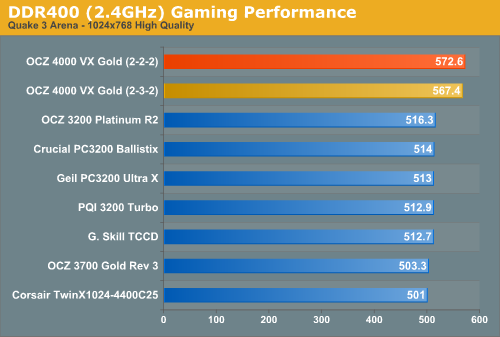
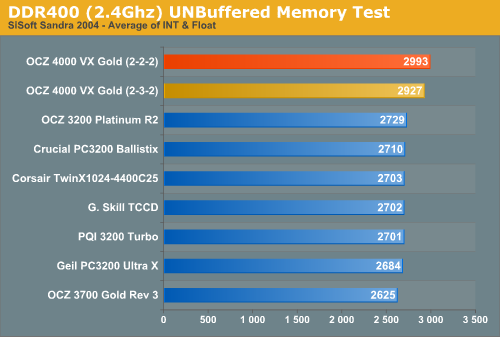
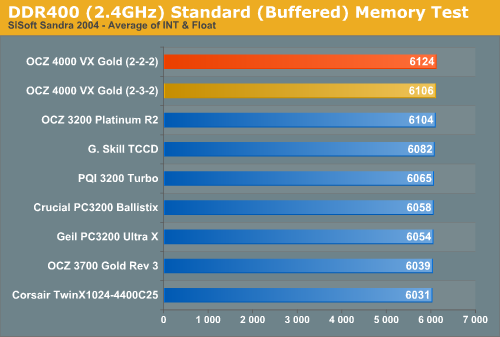
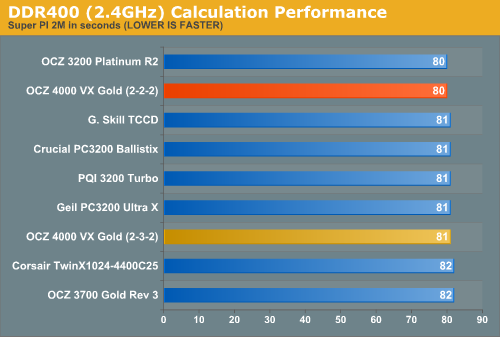
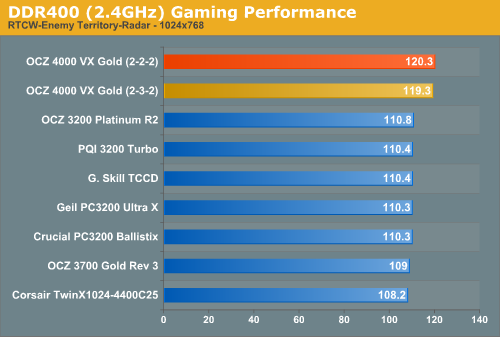
DDR436/2.4GHz Performance
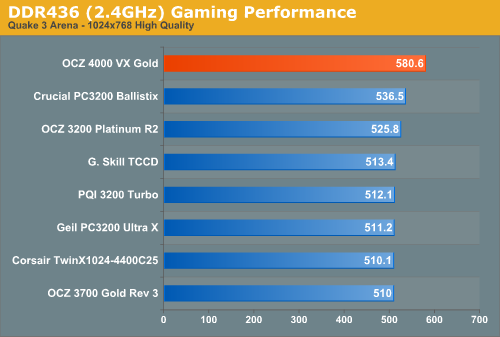
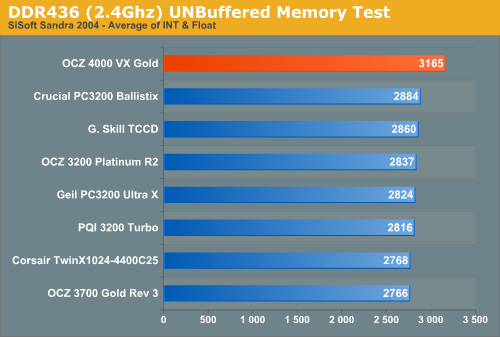
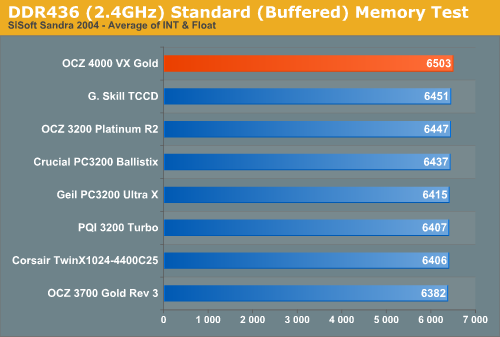
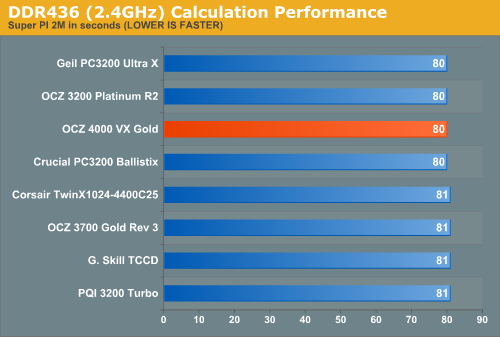
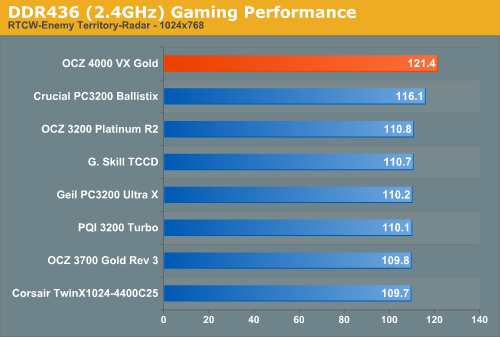
DDR480/2.4GHz Performance
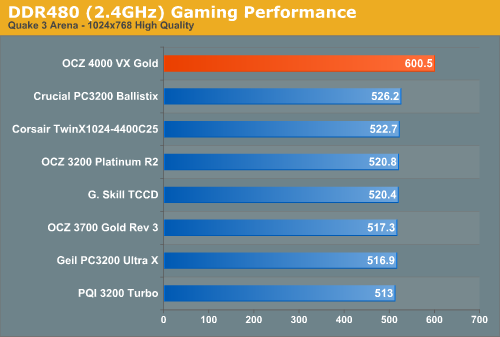
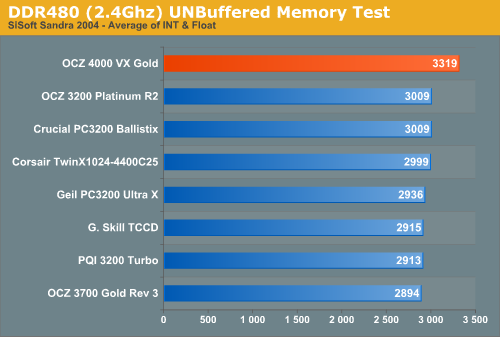
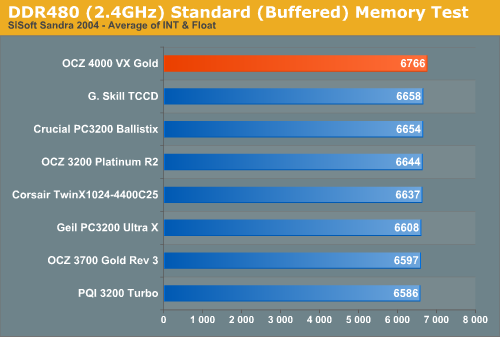
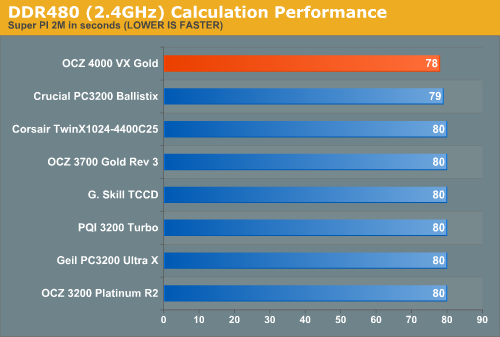
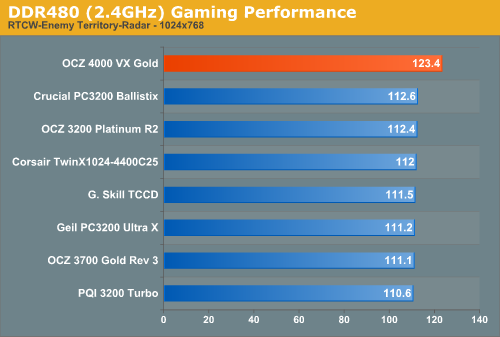
DDR533/2.4GHz Performance
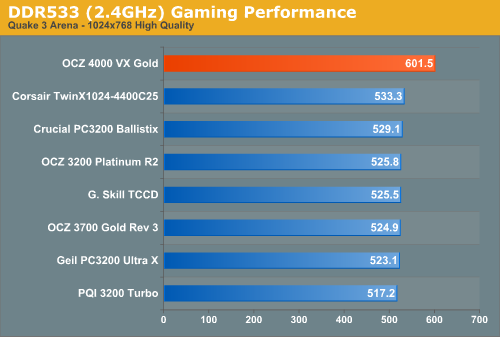
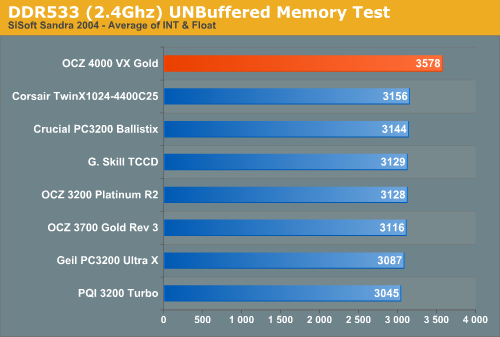
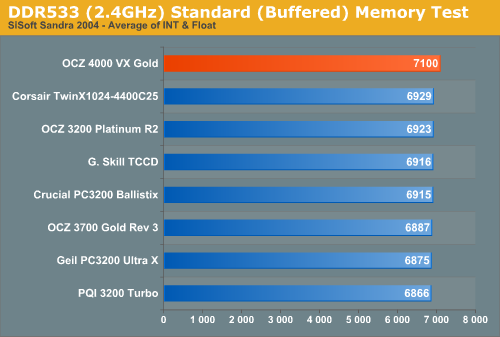
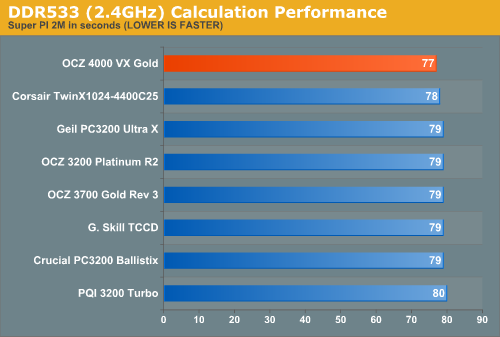
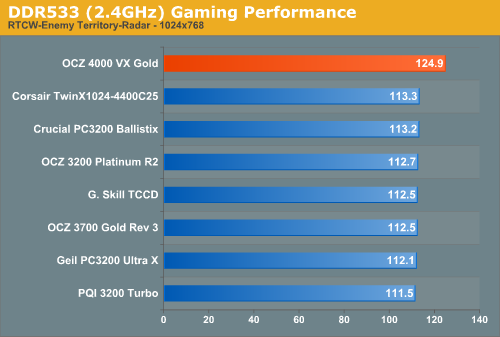
Highest Memory Speed Performance
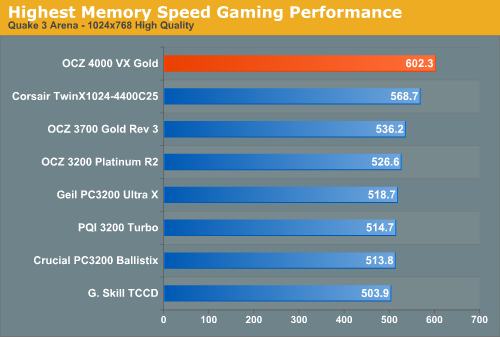
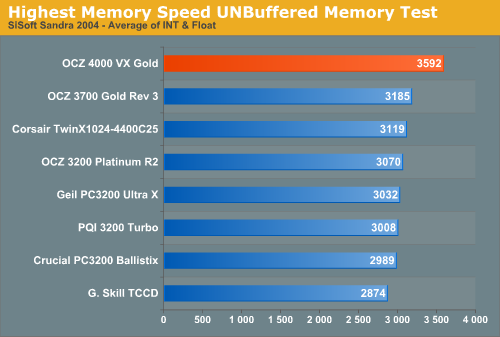
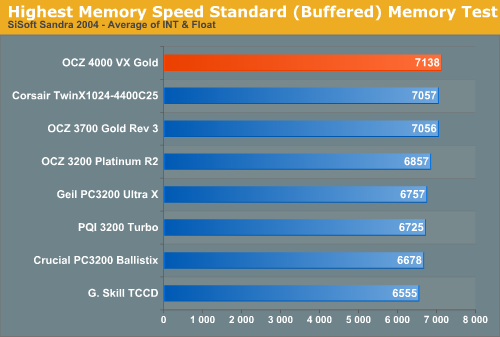
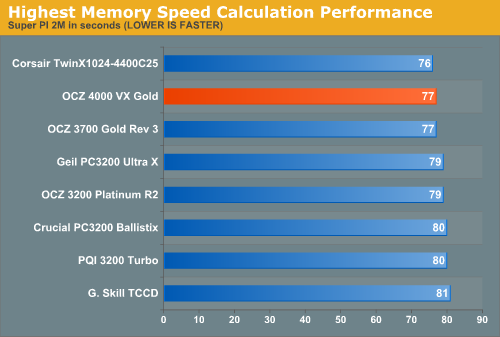
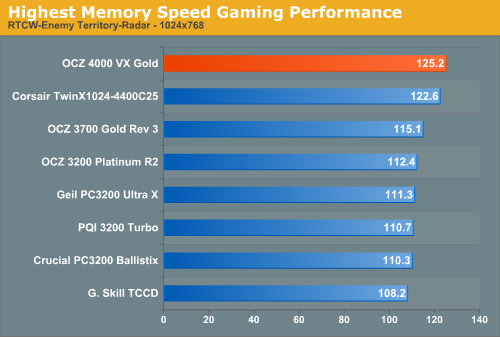
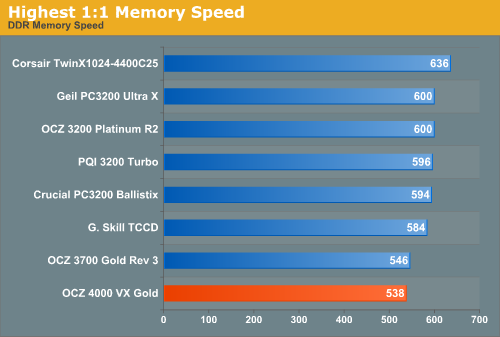
Highest Performance
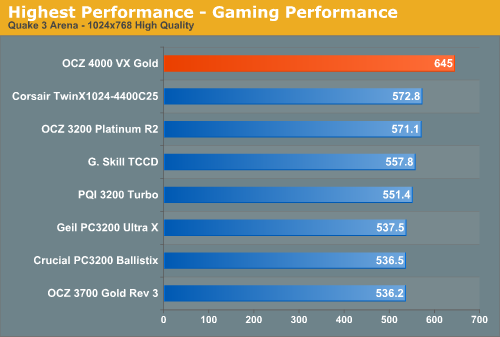
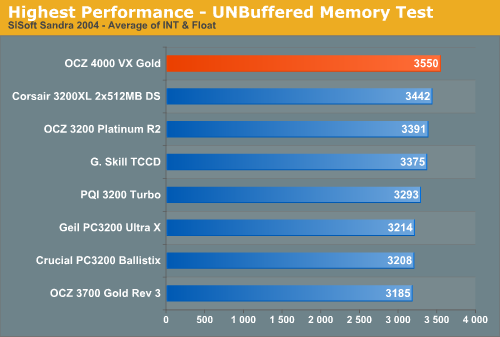
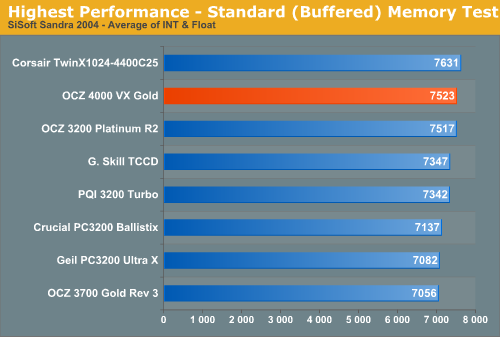
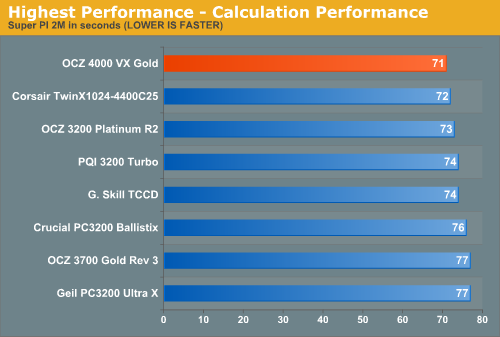
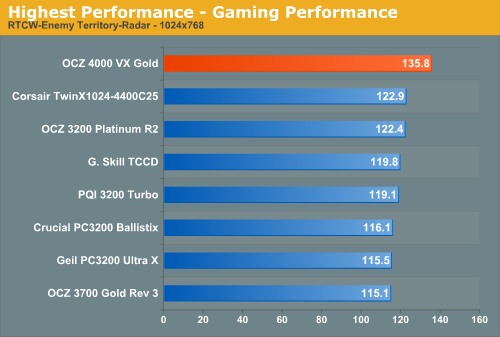
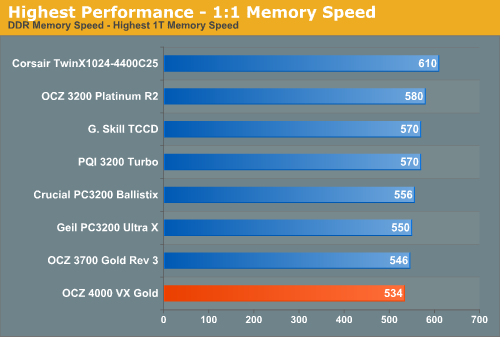
Final Words
There is some interesting creative thinking going on at OCZ these days. OCZ threw CAS out the window and brought us their EB, or Enhanced Bandwidth, memory. Now, we see the standard JEDEC voltage of 2.6V (or 2.5V from the past) thrown out the window with VX, or eXtended Voltage, memory taking its place. Breaking rules is one way of making performance gains in this industry, but it only matters if the results justify the rule-bending. EB proved to be a great performer, and now OCZ VX extends the envelope even further. If I sound excited, it is because I am. The new OCZ EL PC4000 VX Gold is a mouthful of a name and a pot-load of new performance records.Some of you may recall in the last days of BH5 memory last year that BH5 actually performed faster than the new Samsung TCCD at the exact same memory timings. This is a pattern that we have seen before, but OCZ 4000 VX Gold blows the hinges off the door of this concept. What can you say about a memory that outperforms the fastest memory that you have previously tested, except "wow"? What replaces "wow" when you realize that OCZ VX running at DDR533 outperforms the previous best running at DDR610? There are no superlatives that really do justice to this kind of performance. We are absolutely blown away with the performance of the OCZ DDR500 VX.
Across the board from DDR400 to DDR538, VX manages to perform with stability in all our benchmarks at 2-2-2-6 timings. In addition, it is faster at the same timings than any memory that we have tested so far. This is why DDR533 outperforms the top TCCD memory - even those specially binned for highest-speed performance. We would also add that we did try slower timings to see where we could go, but this memory is very interesting in its performance curves. It can do, at 2-2-2 at high voltage, essentially the same as the highest OC at lower timings at any voltage. This is another way of saying that there is absolutely no reason to run VX at any timings other than 2-2-2 - unless you simply don't have the voltage to reach 2-2-2 performance.
This brings us to the handicap with VX, and it will be a huge one for many users. VX requires high voltage to stand out from crowd - voltages not generally available on standard motherboards. You will need to start about 3.0V and extend to at least 3.5V to 3.6V to get the most from VX memory. The good news is that OCZ still provides a lifetime warranty on VX even if you run it all day long at 3.5V.
The new DFI nForce4 motherboards, both Ultra and SLI, supply voltages at stock to 4.0V. They are a very good match to VX and will take VX to whatever heights it can reach in your setup. If you have a board that you love or you're thinking of one without these extreme voltage ranges, then you can still feed VX what it needs with the OCZ DDR Booster, but you will give up a DIMM slot (translate to pair in dual-channel) to run the DDR Booster. At least there are options available, and for many enthusiasts, it will be worth the effort to find a way to use VX.
In the end, OCZ VX Gold is the best performing memory that we have tested on the Athlon 64 platform. At the same speed and same timings, it significantly outperforms any other memory that we have tested on A64. VX does not run at the fastest memory speeds that we have found in our benchmarks - quite a few memories based on Samsung TCCD or Hynix memory chips reach significantly higher speeds than the DDR538 of OCZ VX Gold. However, at DDR534 2-2-2-6 timings, no memory that we have tested outperforms VX. VX is so fast that 533 actually outperforms memory that have achieved DDR600 or more in our memory tests.
If you are a raving enthusiast, you will have to have OCZ VX memory. If you are considering a DFI nForce4 purchase, then VX should be at the top of your memory list. If you want top performance, then you should at least consider OCZ Gold VX even if it requires a DDR Booster to run. Yes, OCZ PC4000 VX Gold is that good!







